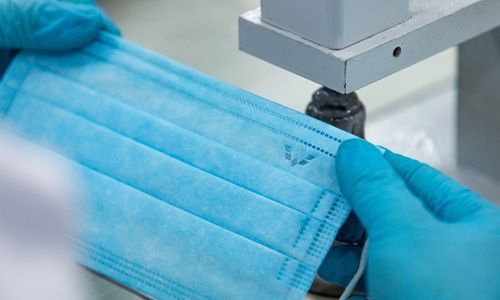HOME >> SOURCE
Taiwan’s ambition to be world’s No.2 mask producer likely to be a mirage
Source:Global Times Published: 2020/3/5 21:58:40

A mask bearing the Wuling logo. It took just three days for domestic auto brand SGMW to convert its production line from auto to face masks and send out its first shipment amid the nation's fight against the coronavirus. Photos: Courtesy of SGMW
The Island of Taiwan has claimed it would become the world's second-largest mask producer with a daily output of over 10 million soon, but that fond dream is up in the air as the island relies on imported raw materials that are in great shortage around the world, said industry players.
Despite the island's claims that its mask production has increased to 8.2 million a day from 7 million a day last month, insiders told the Global Times that Taiwan traders are scrambling for mask orders from the Chinese mainland, which has an ability to produce 100 million masks a daily now.
Taiwan may have the production capacity to produce 10 million masks a day, but it is seriously short of raw materials for which it relies on imports, such as melt-blown fabric, which is very much craved for around the world, Chen Lianjie, general manager of protective suits maker Zhejiang Longtai Medical Technology Co, told the Global Times on Thursday.
Another insider surnamed Huang cast doubt on whether the Taiwan island has enough raw materials to support its masks production ambition.
Huang said prices of melt-blown fabric have been surging lately due to the increasing demand on the world. Chinese mainland and Germany are the main producers of that material, he said.
Before the coronavirus outbreak, the majority of masks in Taiwan were imported, with up to 93 percent from the mainland, which is now facing a mask shortage, according to a report from the Straits Times.
Taiwan's ambition to produce masks comes as world demand for masks is skyrocketing as the coronavirus is spreading to all corners of the globe.
"With only 23 million residents, but with 10 million daily production of masks, the island may be preparing for exports," Huang said.
Mask production involves a complicated industrial chain and many factors are needed, such as equipment, melt-blown cloth, ear cords, and nosepiece strips, said Tony Tan, vice general manager at Shanghai Dragon Corp, noting that the mainland has the most complete industrial chain in the world.
"The Chinese mainland makes more than 50 percent of the world's masks. When the world is facing a tight mask supply, it might still count on us to meet that demand," Tan told the Global Times.
Before the virus outbreak, the mainland's maximum production capacity of masks was more than 20 million per day. It has been striving to increase the daily output to over 110 million.
To help meet global demand, Tan said his company is consulting overseas customers about their actual demands in Japan, South Korea, Europe and the US, as well as local laws and regulations and their mask usage standards.
Posted in: INDUSTRIES,BIZ FOCUS